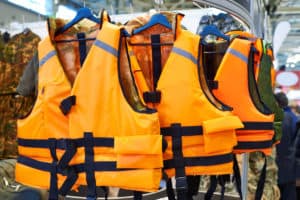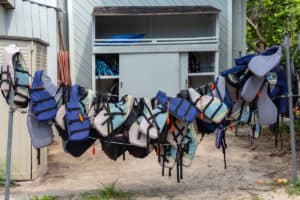What causes a PFD to wear out over time?
If you are a boat owner, it’s essential to know what may cause your Floatation Device to wear out. It is necessary for safety that you have a PFD for every person on your boat, and that they are in good working order. Proper storage can increase the life span of the PFD’s on your boat.
boat, and that they are in good working order. Proper storage can increase the life span of the PFD’s on your boat.
The common causes of a PFD wearing out are Ultraviolet Radiation, Moisture, Rips or Tears, and Improper storage
Lets now take a look at each cause as well as a few things you can do to help increase the life span of your PFD’s. I’m sure you don’t want to spend more money on new PFD’s because you didn’t properly care for them.
Ultraviolet Radiation
The rays from the sun are one of the greatest threats to your PFDs. Exposing your PFD to direct sunlight when not in use will lead to them wearing out faster. The sun destroys the synthetic materials that the floatation device is made of. The effect of the sun on your PFD can be realized by the fading of its original colors. Ensure that you store your PFDs away from direct sunlight.
Moisture and Humidity
PFDs should only be stored dry. After using them make sure to let them fully dry before putting them away. storing them while wet or moist causes the buoyant materials to ware out. Ensure you dry your PFDs immediately after using them and before putting them in storage. Leaving moisture in the jacket will also cause it to get moldy.
Improper storage
PFDs should be stored in a line or a manner that allows the passage of air between them. Storing them in bundles can make them trap any moisture that’s still on or in them. Hence causing them to grow moldy and interfering with the buoyant part of the PFD.
Rips or Tears
Sharp objects like metals and glass can tear PFDs. Sometimes metallic or sharp edges of the boat can tear your PFDs without you noticing. Hence, it’s useful to check them for any damages before usage.
How to care for your PFDs?
Proper PFD Storage
Make sure your PFDs are dry before you put them in storage. They should be stored in a manner that allows the free circulation of air. Remember to keep them away from direct sunlight. Store the PFDs in a cool, dry place free from any contamination.
Check PFDs before Use
Test the PFDs before the actual usage. Despite PFDs being your insurance policy in water, most people don’t take the time to test them. Failure to check them for effectiveness before going out boating could mean it fails to save you in the sea or on the water in case of any emergency. If you are using inflatable PFDs, check for air leaks.
Don’t Alter Your PFDs
Altering will affect the integrity and effectiveness of the PFD. PFDs come in different sizes, making any alterations to make them fit you better could damage the PFDs. You should always ensure you have various sizes of PFDs on hand if your boat can accommodate multiple people.
Do you know when you need to replace your PFD?
PFDs are sometimes subjected to wear and tear. It is imperative to replace them whenever they are worn out to enhance your safety in the water. So when do you need to replace your PFDs? Aging of PFDs calls for replacement. The more you use your PFD, the more it is likely to decrease in effectiveness and functionality. When your PFD starts fading from its original color, it could be a sign of aging hence the need for replacement. PFDs are not something you can repair they need to be replaced. In the case of any wear or damage make sure to replace your PFD before going out on the water.
Worn or Weak Fabric
PFDs are made of synthetic materials that are subject to wear under normal conditions. Some parts of the PFD, i.e., the shoulder strap, are helpful in the moments of rescue. When your shoulder straps are worn out, rescue attempt may fail if it tears when trying to lift you. Ensure that you inspect the critical parts of your PFDs regularly and, if you have any doubt, replace the PFD immediately.
Loss of Buoyancy
The foam and floatation of your devices may be compromised over time. It’s recommended to test the buoyancy of your PFD regularly, i.e., monthly. Your PFD should keep your body comfortably afloat, i.e., head above water. To test for buoyancy, you wear the PFD and go into the water until it is chest height then bend your knees so that your feet come off the bottom. The PFD should take over, and as long as it’s working right you’ll float. You will also discover the height the PFD will keep you at when floating so you can adjust it if needed.
Inflating PFD’s
The fabrics of inflatable PFD weaken over time, making it challenging to know when to replace them. For cartridge inflatable PFDs, when you can check the cartridge to see if it’s usable or not. If it’s unusable, purchase a new PFD. You may want to consider just replacing the cartridge annually on the PFD, this way you won’t run the risk of it not working in the event of an accident.
 What to look for when buying PFDs
What to look for when buying PFDs
The choice of the PFD to buy is dependent on individual taste and preferences. PFDs have different designs and purposes, i.e., for men and women. Ensure the PFD fits you comfortably before you decide to purchase it. Numerous factors will influence your choice of PFD, as discussed.
Colour
PFDs are approved to be manufactured in different colors. Just remember that color can be critical in the event of an accident on the water. Colour is necessary for visibility from a long distance. Choose a color that will be noticeable from far, i.e., a color not similar to your boat or the bluish color of the water. You may also never want to choose white, in choppy water it can be hard to pick it out from the white caps of the waves. The color will help other boaters spot you.
Pockets and Attachment Points
The shoulder strap should be full and robust enough to ensure the shoulder strap of the PFD can pool you. Other attachment points where you can store safety equipment, i.e., knives, whistle, and radios, should also be considered. This is majorly effective for water tourists; however, paddlers should ensure the PFD is light enough to prevent the risk of entanglement.
Rescue Attachments
Paddling in more challenging conditions, you should consider a PFD with attachments for towing in case of any incidences in the water. A throw bag is also necessary for such type of activities.
Government Approval
Ensure the PFD you plan to purchase has a government approval or seal on it. This regulation ensures the PFDs are well tested and approved for water usage.
Conventional vs. Inflatable PFD
Inflatable PFDs provide more options to choose from. They have a reduced bulk and are cool in hot weather. However, for their effectiveness, you must understand their requirements and limitations. Be sure to do some research before you buy an inflatable PFD to make sure its right for what you’re going to be doing.
Type of Craft
The type of craft will determine the kind of PFD to buy. If you are using a kayak and you are paddling using a spray skirt, purchase a PFD short enough in the torso to fit above your skirt. Paddleboarders who are leashed to their boards might want to use an inflatable design. Touring kayaks are best used when full torso styles with pockets to carry some items like snacks.
Sizing
PFDs are manufactured in different sizes. Ensure the PFD is your size before you buy it. A PFD can not be altered since alteration affects their integrity; hence it’s necessary to acquire the right size PFD, i.e., the one that fits you best. If you want to buy for family, ensure the sizes are perfect for each member.
Buoyancy
Adults require additional 3-5kg of buoyancy to keep them afloat. Ensure the PFD meets the government minimum set requirement before you purchase it. The body type and weight should determine the type of PFD you choose based on buoyancy.
Dues and Don’ts with your PFDs
Things to Do With your PFD
- Always check it before going out on your boat and at the beginning of every season
- Check for any tears
- Confirm all the straps are in right working conditions and firm on the PFDs
- Check for lumpy buoyancy materials or any saturated or oily fabrics
- Ensure the labels are still attached and approved by USCG
Things to Avoid With your PFD
- Do not use as a kneeling pad
- Never remove the label, straps or any buckles
- Do not use cleaning detergents on them
- Do not sew anything on the life jacket
How to Test a PFD effectiveness
How will you know that your PFD is sufficient? Consider checking for the following
- Ripped or torn material.
- Zippers or straps that don’t work.
- Labels that are illegible.
- Material that is weak or discolored.
- Be sure to throw away and replace any of your defective PFDs.
The Best PFDs on the Market
Here are some of the best PFD jackets in the market.
Astral V-Eight Life Jacket PFD
The jacket has a buoyancy of about 16pounds. The jacket comes in different colors, sizes, and variations. It’s made of mesh and has proper ventilation to help with sweating while in water.
Pros
- Breathable mesh back
- Unisex design
Cons
- Padding by zipper makes it slightly challenging to zip up
NRS Ninja PFD Charcoal S/M
This one has a flotation rating of 16.5 pounds and its coast guard approved. It has two shoulder straps for easy adjustment. It does not have foam around the arms making it a good choice for paddlers. It has less fabric allowing your arms to move more freely while putting it on.
Pros
- Adjustable shoulder straps are suitable for different body sizes
- Approved by the coast guard
Cons
- Lacks foam around the shoulders
- Has no mesh on the back
NRS Chinook Mesh Back PFD
This jacket has a buoyancy rating of 16.5 pounds as well and like the others, it is also US Coast Guard approved. It has a series of storage compartments on it and attachments. It is made of mesh on the lower back so you won’t sweat as bad if you’re wearing it all day. This flotation device is highley durable and stands up to rough surfing situations.
Pros
- Incredible storage and attachments
- Extremely durable
Cons
- The mesh isn’t as comfortable
Conclusion
Ensure your PFDs are stored in recommended conditions. PFDs are your water insurance policies hence should be serviced regularly to help survive any challenges in water. Choose PFDs that are durable and comfortable for your use and make sure to test them at least once a year.